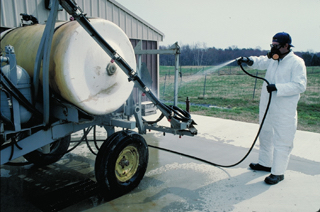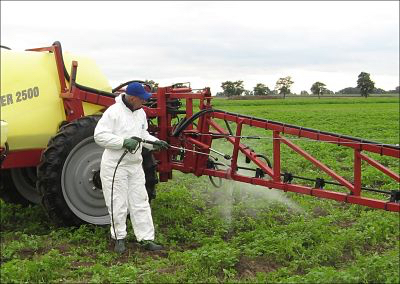
Clean that sprayer – credit Univ. of Nebraska.
It is very likely that you will not be using your sprayer again until next spring. If you want to avoid potential problems and save yourself from frustration and major headaches, you will be wise to give your sprayer a little bit of TLC (Tender Loving Care) these days. Yes this is still a busy time of the year for some of you, but don’t delay winterizing your sprayer too long if you already have not done so. You don’t want a pump that is cracked and/or not working at its full capacity because you did not properly winterize it before the temperature falls below freezing. Here are some important things you need to do with your sprayer this time of the year.
Rinsing
It is very likely that you did the right thing when you used the sprayer the last time: you rinsed the whole system (tank, hoses, filters, nozzles) thoroughly. If you did not, make sure this is done before storing the sprayer. A sprayer that is not rinsed thoroughly after each use, and especially after the spraying season is over, may lead to serious problems caused by cross-contamination of different products applied for different crops. Another problem that may result from lack of, or insufficient rinsing of the complete sprayer parts is clogged nozzles. Once the nozzles are clogged, it is extremely difficult to bring them back to their operating conditions when they were clean. Leaving chemical residues in nozzles will usually lead to changes in their flow rates, as well as in their spray patterns resulting in uneven distribution of chemicals on the target.
Depending on the tank, proper rinsing of the interior of the tank could be easy or challenging. It will be very easy if the tank is relatively new and is equipped with special rinsing nozzles and mechanism inside the tank. If this is not the case, manual rinsing of the tank interior is more difficult, and poses some safety problems such as inhaling fumes of leftover chemicals during the rinsing process. To avoid these problems, either replace the tank with one that has the interior rinse nozzles, or install an interior tank rinse system in your existing tank.
For effective rinsing of all the sprayer components, circulate clean water through the whole sprayer parts several minutes first with the nozzles off, then flush out the rinsate through the nozzles. Rinsing should be done preferably in the field, or on a concrete chemical mixing/loading pad with a sump to recover rinse water. Regardless, dispose of the rinsate according to what is recommended on the labels of the pesticides you have used. Always check the label for specific instructions. However, most labels recommend following procedure: If rinsing is done on a concrete rinse pad with a sump, put the rinsate collected in the sump back in the tank, dilute it with water and spray it in the field where there is no potential for the rinsate to reach ditches and other water bodies nearby. If the rinsing is done in the field, make sure you are not flushing out the rinsate in the system in one area. It is best to further dilute the rinse water in the tank and, spray it on the field on areas where there is no potential for the rinsate to reach ditches and other water bodies nearby.

Don’t forget to clean your sprayer – credit Tops-Life.org
Cleaning
Rinsing the system with water as explained above may not be sufficient to get rid of chemicals from the sprayer. This may lead to cross-contamination problems. Residues of some pesticides left in the sprayer may cause serious problems when a spray mixture containing these residual materials is applied on a crop that is highly sensitive to that pesticide. To avoid such problems, it is best to clean and rinse the entire spraying system with some sort of a cleaning solution. Usually a mixture of 1 to 100 of household ammonia to water should be adequate for cleaning the tank, but you may first need to clean the tank with a mixture containing detergent if tank was not cleaned weeks ago, right after the last spraying job was done. Some chemicals require specific rinsing solution. There is an excellent Extension Publication from University of Missouri which lists many commonly used pesticides and the specific rinsing solutions required for them. It is available online. Check it out (http://extension.missouri.edu/p/G4852). However, you should always check the product label to find out the most recent recommendations on cleaning agents.
Cleaning the outside of the sprayer components deserves equal attention. Remove compacted deposits with a bristle brush. Then flush the exterior parts of the equipment with water. A high pressure washer can be used, if available. Wash the exterior of the equipment either in the field away from ditches and water sources nearby, or a specially constructed concrete rinse pad with a sump. Again, the rinsate should be disposed of according to the label recommendations. As I mentioned earlier, most labels recommends the same practice: put the rinsate collected in the sump back in the tank, dilute it with water and spray it in the field where there is no potential for the rinsate to reach ditches and other water bodies nearby.
Winterizing
Check one more time to make sure there is no liquid left inside any of the sprayer parts to prevent freezing. Especially the pump, the heart of a sprayer, requires special care. You don’t want a pump that is cracked and/or not working at its full capacity because you did not properly winterize it before the temperature falls below freezing. After draining the water, add a small amount of oil, and rotate the pump four or five revolutions by hand to completely coat interior surfaces. Make sure that this oil is not going to damage rubber rollers in a roller pump or rubber parts in a diaphragm pump. Check the operator’s manual. If oil is not recommended, pouring one tablespoon of radiator rust inhibitor in the inlet and outlet part of the pump also keeps the pump from corroding. Another alternative is to put automotive antifreeze with rust inhibitor in the pump and other sprayer parts. This also protects against corrosion and prevents freezing in case all the water is not drained. To prevent corrosion, remove nozzle tips and strainers, dry them, and store them in a dry place. Putting them in a can of light oil such as diesel fuel or kerosene is another option.
Storage
Find ways to protect your sprayer against the harmful effects of snow, rain, sun, and strong winds. Moisture in the air, whether from snow, rain, or soil, rusts metal parts of unprotected equipment of any kind. This is especially true for a sprayer, because there are all kinds of hoses, rubber gaskets and plastic pieces all around a sprayer. Yes, the sun usually helps reduce moisture in the air, but it also causes damage. Ultraviolet light softens and weakens rubber materials such as hoses and tires and degrades some tank materials. The best protection from the environment is to store sprayers in a dry building. Storing sprayers in a building also gives you a chance to work on them any time during the off-season regardless of weather. If storing in a building is not possible, provide some sort of cover. When storing trailer-type sprayers, put blocks under the frame or axle and reduce tire pressure during storage.
Finally, check the condition of all sprayer parts one more time before leaving the sprayer behind. Identify the parts that may need to be worked on, or replaced. Check the tank, and hoses to make sure there are no signs of cracks starting to take place. Check the painted parts of the sprayer for scratched spots. Touch up these areas with paint to eliminate corrosion. By the way, don’t forget to cover openings so that birds don’t make a nest somewhere in your sprayer, and insects, dirt, and other foreign material cannot get into the system.



